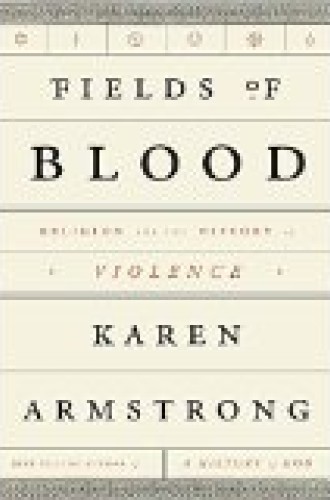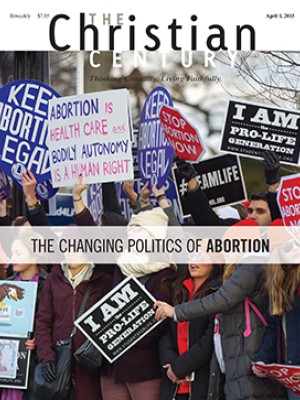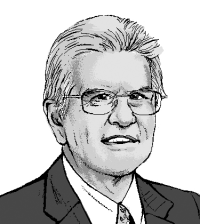Holy terror
Readers might disagree with Karen Armstrong’s specific arguments, but never has she been faulted for lack of scholarly ambition. The author of A History of God (among many other books) regularly tackles massive topics of pressing significance, ranging freely over the millennia and across continents. Her willingness to paint on a very large canvas is abundantly evident in Fields of Blood, which traces the age-old relationship between religion and violence.
Discussing that connection is timely in an era when so many acts of terrorism and warfare are credited to faith. From Voltaire to Richard Dawkins, that linkage has provided a potent rhetorical weapon to atheists and secularists attacking religion. Obviously, say such critics, religion has throughout history sparked wars and driven persecutions, and it will continue to do so until humanity evolves beyond its childish mythologies.
Read our latest issue or browse back issues.
To visualize the antireligion argument, we might think of a video showing the World Trade Center in flames to the accompaniment of John Lennon’s song “Imagine”: “Imagine no religion. . . . Nothing to kill or die for.” Movements like the one behind the so-called Islamic State demonstrate to many people that a world without God would be more peaceful, as it would be a world with fewer reasons to hate. If you are fighting for God against the devil, the argument goes, then there can be no peace short of annihilating the enemy.
Armstrong flatly rejects such easy equations. She admits that wars have often been framed in terms of faith and that none of the world’s religions can boast of clean hands in this regard. But she places the primary blame for violence on changing social and economic circumstances, which create larger and more aggressive political entities, commonly headed by warrior elites and dynasties. Armstrong sees a Darwinian pattern: lands with less determined and less confident elites are rapidly swallowed up by their harder-edged neighbors. For multiple reasons, ancient and medieval states sponsored and supported official faiths, which channeled and consecrated warrior ideals. All religions do this to varying degrees.
To oversimplify Armstrong’s argument: states happen, wars happen, and religion blesses them. Religion thus provides a rhetorical framework for warfare—but not, she argues, the motivation.
We should not imagine a feudal lord sitting quietly by his fireside until some sackcloth-clad religious fanatic, shrieking threats of hellfire, induces him to launch an attack on his less pious neighbor. Very probably something like the Arab conquest of the Middle East would have occurred in the seventh century even without the rise of Islam. Justification is not causation.
We blame religion for such acts because in many early societies scholarship and learning tended to be the preserve of religious institutions. Wars and state actions were thus recorded and lauded by faith-driven scribes, who wasted no opportunity to stress their underlying religious motives and to exaggerate those retroactively. Religions are much to blame for shaping our later image of such early struggles, but they did not actually cause the violence.
Moreover, the state’s alliance with religion is a complex matter: it is difficult to avoid the obvious medieval metaphor of the double-edged sword. While faith sanctifies warfare and military values, societies imbued by religious values tend over time to be more influenced by their humanitarian and nonviolent ideals.
The scope of Fields of Blood is impressive, including substantial case studies from India, China, and Japan, as well as more obvious examples from Christendom and the Islamic world. Particularly valuable is the book’s long historical span, which allows the reader to trace not just the early history of warrior faith in such societies but also its evolution in modern times. Armstrong shows, for instance, how modern-day religious extremists in the Hindu and Muslim worlds have grounded their actions (often implausibly) in the imagined history of ancient warriors.
That long historical reach allows Armstrong to argue very convincingly against some modern clichés about religious violence. Most powerfully, she shows beyond debate that in modern times no religion has done nearly as much as secular ideologies have to foster violence. And most of those ideologies (above all, communism) have themselves been aggressively materialistic and antireligious. This fact is, or should be, so obvious—and the scale of the savagery so starkly evident—as to end once and for all the canard that faith causes violence. As she argues, religion has become a scapegoat for contemporary explanations of violence, cited most frequently by the historically impaired.
More controversially, Armstrong’s readers will have a hard time arguing for the inherently violent nature of any one faith, a charge that in modern times attaches particularly to Islam. She knows a great deal about Islam and writes at length about some of its uglier modern manifestations, but argues that modern-day extremism must be understood in the context of contemporary social and political strains rather than any supposed toxins in Islam’s DNA. Religions develop according to complex historical circumstances, rather than being circumscribed by their founding scriptures.
If Islam is uniquely conducive to producing acts of terrorism, it is odd that Muslims were such latecomers to the world of 20th-century terrorism, a landscape already thoroughly charted by fascists, nihilists, anarchists, communists, and miscellaneous nationalists. Nationalism, in fact, receives here much of the blame for acts commonly characterized as religious.
Readers will also learn how all faiths have been thoroughly adept at deploying scriptures to justify mayhem and massacre over the centuries. The Bible itself has repeatedly been used for such purposes in particular political settings, and that is exactly Armstrong’s point: it is the settings that drive the violence, not the texts themselves, nor the associated doctrines. Nothing in the Qur’an itself can be directly blamed for contemporary Islamic extremism.
I cannot imagine anyone who would fail to find new information or insights in Fields of Blood, which makes nonsense of so many antireligious rants. Yet precisely because it stakes claims in so many different areas—that it operates in so many fields—it inevitably arouses some disagreement.
For example, Armstrong rightly stresses that we should be careful about defining the limits of “religion” in most societies up to very modern times, or in drawing too sharp a line between categories such as social, economic, and spiritual. It is difficult to blame a particular act on “religion” when religion was scarcely recognized as a separate sphere of life until at least 1700. If everything is broadly religious, then we cannot single out religious motives for something like the Spanish Inquisition, which should really be understood in terms of political stresses.
Yet we could turn that argument on its head. Yes, we might say, a particular massacre or persecution was really driven by crop failures and popular despair rather than by religious doctrine. But does that mean that it was not in some broad sense also religious?
Throughout history, most people have accepted broadly providential views of the world. They believed that wrong conduct or heretical belief stirred God to anger and that such anger would be expressed in highly material terms—in earthquake and fire, invasion and military defeat, famine and pestilence. Unless evildoers or wrong-believers were suppressed, society might perish altogether. In order to destroy malevolent groups, activists took steps that look worldly, political, and cynical, but we can never truly separate those political steps from their compelling underlying motivation, which was supernatural—understood according to the faith prevailing at the time in question.
Religion is a very broad tent, which is not just confined to institutions and isms. I actually have no problem in seeing something like the Inquisition as a thoroughly religious affair in this broad sense of the term, as well as a specifically church-oriented one.
In analyzing modern times, again Armstrong protests too much. She tries too hard to explain away the religious character of events and movements that most observers would certainly categorize in religious terms. Repeatedly, she urges us to see the social, economic, and political contexts at work in particular situations, and she is certainly correct to do so. But that wider understanding does not, or should not, allow us to remove the religious context or to see the religious rhetoric and symbolism as mere window dressing.
Even if a given movement is thoroughly shaped by political and social circumstances, we cannot ignore the religious quality through which it expresses its beliefs, not least because an authentic believer will see the hand of God at work in both politics and society. No, religion is not the sole culprit for contemporary global mayhem. But neither can it be exonerated.
We can draw up lengthy lists of the circumstances that drive a young Arab citizen of France to travel to Syria and become a suicide bomber. We can identify the racism, deprivation, and lack of educational opportunity that shaped his life. The fact remains that the identity he acquires is religious, and religion provides the lens through which he sees his sufferings as the result of an infidel West that rejects Islam. His subsequent actions must be understood as religiously motivated and defined according to the traditions of one particular faith. He is engaged in religious violence, and it is silly to pretend otherwise.
A similar point might be made about the many modern incidents of bloodthirsty conflict between communities that define themselves in religious terms. Armstrong has little sympathy, for instance, for any attempt to invoke religious motivations for the appalling conflict between Hindus and Muslims during the partition of India in the 1940s, and to some extent, she is right. If you had interrogated a homicidal Islamic militant (say) about the core beliefs of his faith, he might have proved thoroughly ignorant, making it hard to view him as an authentic jihadi warrior. In the place of religious faith, she invokes another demon figure: “Muslims and Hindus would both fall prey to the besetting sin of secular nationalism: its inability to tolerate minorities.”
But would the same militant have been any better informed about the details of secular nationalist ideology, beyond a generalized hatred of those who dressed and ate differently? Armstrong scapegoats secular nationalism in very much the same way that other critics blame religion for any and all atrocities.
I personally am less skeptical of the specifically religious claims of communities engaged in such violence, but not, of course, because indiscriminate warfare belongs to the belief system of any of the great faiths. Rather, the fact that communities define themselves thus—as Hindu, or Catholic, or Buddhist—genuinely does mean that they have through the centuries been molded by those values and traditions, however much they have transformed and secularized them. To adapt Emerson’s words, that spiritual past had baked their loaf.
When Indians in the 1940s committed acts of hatred in the name of Ram or Allah, we should at least respect the history that had driven them to such
an intolerant and xenophobic identification, even as we utterly condemn the crimes themselves. Religious wars have occurred in the past and still happen today. The last person who will fight and die in such a religious struggle has not yet been born.
Armstrong is at her weakest in addressing very recent times, when her attempts to underplay religion’s role in violence become deeply unconvincing and overtly polemical. At times, her repeated assertions that Islamic terrorism does not conform to true or normative Islam make her an apologist for that faith. Well, perhaps the terrorist acts are not “normative”; they still are incontestably driven by religious motives, which define themselves according to the traditions of Islam.
To take one example of many, Armstrong looks at the countless atrocities committed by Islamic terrorists over the past decade and comments that such freelance fighters “have very little knowledge of the Qur’an, and so it is pointless to attempt a debate about their interpretation of scripture or to blame ‘Islam’ for their crimes.” Her point about interpreting scripture is quite fair, but her comment about not blaming some version of Islam for these acts is grotesque.
A similar comment can be offered about her mischievous suggestion that the reaction of the U.S. government to the 9/11 attacks was just as religiously driven and fanatical as the ideologies that generated those attacks.
Fields of Blood has a terrific amount to offer virtually any reader. At times, though, history and polemic become difficult to distinguish.








